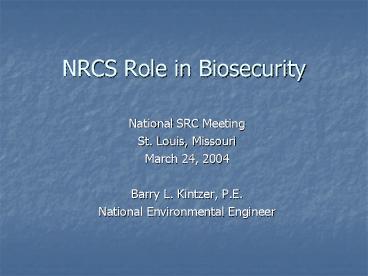NRCS Role in Biosecurity - PowerPoint PPT Presentation
1 / 26
Title:
NRCS Role in Biosecurity
Description:
Exotic Newcastle Disease (Poultry) in California and Arizona June 2003 ... 138 Million Loss to Poultry Industry ... Million Birds (poultry) Destroyed. Tastes ... – PowerPoint PPT presentation
Number of Views:79
Avg rating:3.0/5.0
Title: NRCS Role in Biosecurity
1
NRCS Role in Biosecurity
- National SRC Meeting
- St. Louis, Missouri
- March 24, 2004
- Barry L. Kintzer, P.E.
- National Environmental Engineer
2
Biosecurity
- Broad Meaning
- The literal safety of live things
- Freedom from care for live things
- In Relation to Agriculture
- Protecting livestock from any type of infectious
agent viral, bacterial, fungal, or parasitic
3
Biosecurity - Background
- Modern confined animal production practices have
resulted in the need for better biosecurity. - Recent outbreaks of communicable animal diseases
such as - Foot and Mouth Disease (FMD) in England
February 2001 - Avian Influenza in the Shenandoah Valley area of
Virginia March 2002 - Exotic Newcastle Disease (Poultry) in California
and Arizona June 2003 - have further increased awareness and
demonstrated vulnerability.
4
Biosecurity - Background
- The potential also exists for agrobioterrorism.
- All of these have devastating consequences for
the livestock industry and US agriculture in
general. - 2001 FMD Outbreak in England
- Financial Impact - 3.8 6.5 Billion
- More Than 8 Million Animals Destroyed
- 9,996 Operations Affected
5
Biosecurity - Background
- 2002 Avian Influenza Outbreak in Virginia
- 138 Million Loss to Poultry Industry
- 2002 2003 Outbreak of Exotic Newcastle Disease
- California - 160 Million Spent on Eradication Efforts
- 3.5 Million Birds (poultry) Destroyed
6
(No Transcript)
7
(No Transcript)
8
(No Transcript)
9
(No Transcript)
10
(No Transcript)
11
(No Transcript)
12
Tastes Like Chicken!
13
Biosecurity - Trends
- There Is Anecdotal Evidence That Outbreaks Are
More Likely Due To - Larger production facilities with more animals in
one location - Higher concentrations of animals in specific
geographic regions - Less genetic variation within a given animal
species decreasing potential for natural immunity - Mobility of humans increased national and
international travel - Threat of biological terrorism
14
Biosecurity NRCS Response
- Issued Bulletin No. 130-1-2 dated July 10, 2001
providing guidance to field personnel - Provided reminder by letter from Chief Reed dated
November 9, 2001 with memorandum from the Office
of the Secretary attached - Issued General Manual Policy GM 130 Part 403
Subpart H Biosecurity Preparedness and Response
15
(No Transcript)
16
NRCS Biosecurity Policy GM 130 Part 403 Subpart
H
- Based on guidance provided by APHIS through the
National Food and Agriculture Council (NFAC) - Provides three levels of biosecurity measures
- Level 1 Visits to farms/ranches that entails
office or home visits only - Level 2 Visit to farms/ranches where minimal
contact with livestock/poutlry or their housing
is unavoidable to atain the goal of the visit
17
NRCS Biosecurity Policy(cont)
- Level 3 Visit to farms/ranches where there will
be close contact with livestock/poultry (walking
through narrowly confined pens/lots where animals
are within reach or actually handling/inspecting
the animals) - Level 1 is to be followed at all times
- Levels 2 or 3 may be implemented as recommended
by APHIS and the State Veterinarian
18
NRCS Biosecurity Responsibilities
- Designate an individual in the state to keep up
with the issues and current status of outbreaks - Establish regular communications with the state
veterinarian - Keep employees and partners informed
- USE COMMON SENSE
19
(No Transcript)
20
NRCS Biosecurity Concerns
- Health and safety of NRCS and partner employees
21
(No Transcript)
22
(No Transcript)
23
NRCS Biosecurity Concerns
- Health and safety of NRCS and partner employees
- Health and welfare of livestock and agricultural
production facilities
24
Biosecurity - Challenges
- Adequate funding for states to acquire and
maintain required equipment and supplies. - Adherence to appropriate biosecurity measures
without significantly increasing the time
necessary for field people to deliver programs
and services to producers. - Assurance that TSPs also follow policy and
utilize appropriate biosecurity measures.
25
There are numerous websites that can provide
additional information.
26
(No Transcript)































